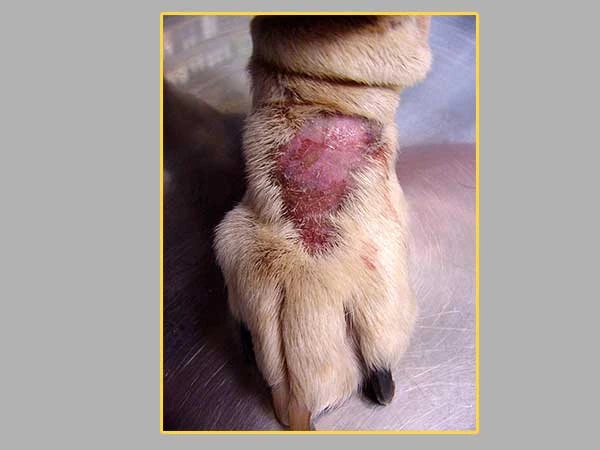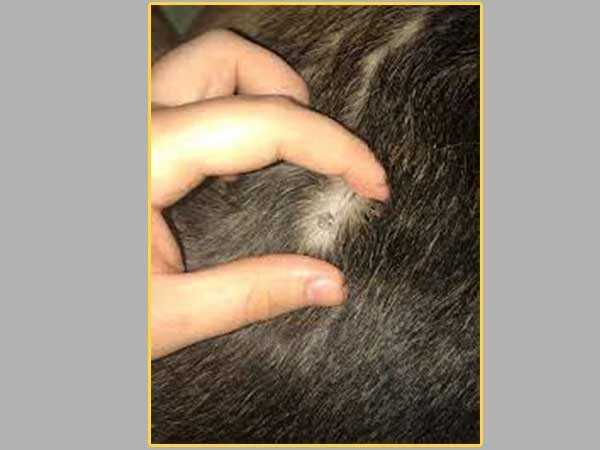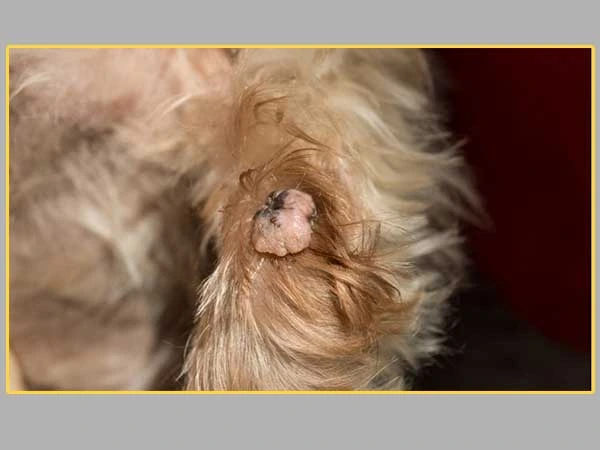What Are the Skin Tags Problems Among Dogs: Causes, Cost and Remedies!
Skin tags are benign growths (tumors) on the skin’s surface that are a fairly typical occurrence in humans (they can also be found in cats but less frequently). Acrochordon, fibroepithelial polyp, and fibrovascular papilloma are some of the medical terminologies for skin tags. They’re usually long and thin, with a short stalk that attaches them to the skin superficially and can be extremely dangly in larger cases. A question that is hit among pet owners is that can dogs get skin tags and What causes skin tags on dogs? Well, the obvious answer is yes, skin tags can appear anywhere on a dog’s body. Skin tags are small, slow-growing growths that can form anywhere on the body. Skin tags develop slowly and can form on any type of dog, though they are more common in larger breeds and middle-aged and older dogs.

Symptoms of Skin Tags
If you notice a growth that resembles a skin tag on your dog, keep an eye on it. Note the size, shape, and color of the object. Keep an eye out for any changes in the neighborhood. If the skin tag doesn’t change and your dog isn’t showing any signs of sickness, it can probably wait until your next yearly or biannual routine wellness exam (don’t forget to mention it to your vet at this visit). Contact your veterinarian for guidance and to schedule an examination of the dog skin tag changes. Some of the common symptoms of skin tags are listed below:
- Licking and Chewing Too Much: If skin tags touch against a collar, harness, or another part of the body, they can easily become irritated or bleed. Some dogs will lick or chew the area around a skin tag, causing inflammation.

- Flattened Growth/Nodule on Skin: Skin tags can take the form of soft, slightly raised, skin-colored lumps, flaps, or wart-like growths (but skin tags are not completely round or dark in color like warts). Hair follicles with thick hair may be found in some of them. Multiple growths in the same location are also possible. Hexal hamartomas are a type of tumor that lacks hair. Follicular hamartomas are hairy lumps in the body.

- Skin Growth that Looks Like a Stalk: Some skin tags are pedunculated, which means they have a stalk attached to them. A dangling growth, as opposed to a flatter growth that can resemble other problems, is most likely a skin tag.

Types of Dog Skin Tags
Skin tags come in a variety of shapes and sizes and they should not be confused with dog wart. While all skin tags are formed by benign skin tissue proliferation, the sort of cells that create the skin tag might vary. These skin tags can’t be distinguished based on their appearance alone; additional testing is required to identify the cells that make up the skin tag. Hamartomas, which are described as a nodule of superfluous tissue, are another name for skin tags on dogs which is of two types, namely:
- Follicular Hamartomas: Follicular hamartomas are a form of fibroadnexal hamartoma that is more common in dogs. Flattened masses with thick hairs characterize these growths, which are typically observed in clusters.
- Fibroadnexal Hamartomas: These are also known as collagenous hamartomas, are common skin tags found in dogs. These are usually hairless growths that appear at the lower limbs and pressure sites.
Causes of Skin Tags
Skin tags are normally not of great concern beyond their cosmetic look because they are benign growths. However, they may become tangled in things or pulled while brushing, causing them to bleed or causing pain and discomfort in your pet; in these circumstances, surgical removal may be necessary.
However, it’s unclear why dogs get skin tags, although they tend to form in regions where there’s a lot of friction, such as chest armpit (where the body rubs on the floor when lying down) and Mammary glands or Abdomen. Some scientists believe friction is part of the underlying cause because they most typically occur in skin creases.
This is also assumed to be the case in humans, as skin tags are common around the neck, shoulders, and armpits. As a result, it’s critical to make sure your dog’s collar or harness is properly fitted.
In humans, there is a relationship between papillomaviruses and skin tags, according to some study. While the viruses involved in dogs are likely to be different, it’s possible that viruses are at least partially responsible for the development of canine skin tags as well (though it’s important to note that true canine papillomas differ slightly from skin tags, emphasizing the importance of having your veterinarian examine any unusual growths).
- Skin tags, according to some authorities, are the result of parasite infections. In such circumstances, it is thought that the skin heals poorly as a result of the feeding damage caused by fleas, ticks, or other pests. This is just another reason to speak with your veterinarian about ongoing flea and tick prevention.
- Skin tags can develop as a result of poor hygiene habits. This can happen if you wash your dog too frequently, not often enough, or with the wrong soaps or shampoos. For the record, most experts advise bathing your dog once a month with a shampoo designed exclusively for canines. Environmental factors, according to some, are to blame. Pesticide exposure or irritating garments and collars are commonly cited by proponents of this school of thought.
- Skin tags may be caused in some dogs due to a genetic tendency. This might explain why skin tags are so common in families. However, this is most likely only a minor contributor to the overall problem.
Cost Involved in the Treatment of Skin Tags
The cost of skin tag removal treatment varies depending on the size and quantity of tags. Depending on the severity of the problem, the price could be much higher. The cost of therapy is also determined by factors such as the treatment modality chosen, the technology available, the experience of the clinician performing the procedure, and the clinic’s location and reputation. To find out the precise cost of skin tag removal procedure, go to a reputable skin clinic.
Prevention of Skin Tags
Though it’s difficult to avoid skin tags, there are several steps you can do to keep your skin healthy and lower the danger of unwanted growths:
- If your dog has a short, smooth coat, apply sunscreen to it.
- Brush often to encourage natural oil secretions and remove dirt, loose fur, and matting that can irritate the skin.
- Reduce dryness and flakiness by feeding your dog skin-healthy food.
- Bathe your dog less frequently and use moisturizing products; over-bathing can cause the skin to become dry.
Remedies of Skin Tags
Due to the lack of a clean atmosphere and specialized tools, attempting to remove skin tags at home can result in blood loss and infection. Chemical-based OTC treatments used for eliminating skin tags at home provide a significant risk of allergic reactions. It is recommended that you see your dermatologist for skin tag removal that is safe, effective, and painless. A professional dermatologist will assess the underlying metabolic abnormality that may be causing the skin tag outbreak and recommend one of the advanced skin tag removal therapies listed below:
- Excision
Excision is a minor surgical technique in which skin tags are removed with a scalpel or surgical scissors. A sharp, sterile scissor will be used by the doctor to snip the skin at the base of a skin tag. You won’t feel anything if the skin tag is small. The doctor may employ local anesthetic or numbing medicine for larger ones. Depending on the size of the skin tag, your doctor may use sutures.
- Cauterization
It is an advanced dermatological procedure that involves employing heat radiation or radiofrequency to burn the skin tag. This is a one-time clinical procedure that takes only a few minutes.
- Cryosurgery
Cryosurgery is a technique that uses liquid nitrogen to freeze a skin tag. This treatment stops the skin tag from growing, and it finally falls off on its own.
- Laser Therapy
Laser technology is used to precisely destroy the skin tag from its base without harming the surrounding skin in this skin tag removal procedure.
- Ligation
It is a physical way of cutting off the blood flow to a skin tag by putting surgical thread around it. As a result, the skin tag gradually falls off.
Skin tags are extremely common, and virtually everyone has them at some point in their lives, but it’s better to see a dermatologist to figure out what’s causing them and how to cure them before they take the form of cancer.
Also Read: Here’s a List of Some Best Kahoot Names









